Services on Demand
Journal
Article
Indicators
-
 Cited by SciELO
Cited by SciELO -
 Access statistics
Access statistics
Related links
-
 Similars in
SciELO
Similars in
SciELO
Share
Revista Latinoamericana de Desarrollo Económico
Print version ISSN 2074-4706On-line version ISSN 2309-9038
rlde no.2 La Paz Apr. 2004
RESEARCH PAPER
Natural Gas and Inequality in Bolivia
Lykke E. Andersen**, Robert Faris
Summary
The increase in Natural Gas sales to Brazil in the coming years will bring about substantial changes in the Bolivian economy. In this paper, we use a general equilibrium model to simulate the changes that will occur in the Bolivian economy and will consider the distributional impacts that are likely to arise from these economic changes.
1. Introduction
Bolivia currently has 55 trillion cubic feet (TCF) of certified Natural Gas reserves and 957 million barrels of certified crude oil reserves.1 This represents a dramatic increase in Bolivia's known natural resource wealth since 1996, where Natural Gas reserves fluctuated around 6 TCF and the oil reserves were economically insignificant.
The dramatic increase in reserves was brought about by an increase in exploration activity which in turn was made possible by two related events: 1) the signing of a Natural Gas export contract with Brazil promising the delivery of 7.1 TCF of Natural Gas over 20 years, and 2) the capitalization of the state oil company, YPFB (Yacimientos Petroliferos Fiscales Bolivianos) which secured a large inflow of foreign investment to the sector.
The royalty value of these extra reserves amounts to several times Bolivia's GDP, so these discoveries represent a substantial positive shock to the Bolivian economy. The shock is so large that it has the power to significantly change the structure of the Bolivian economy for many decades to come. Not all these changes are likely to be positive. Evidence from around the world generally indicate that natural resource rich countries tend to under-perform compared to natural resource poor countries (e.g. Sachs & Warner 1995). Auty (1997, 1998) shows that between 1960 and 1990 per capita incomes of resource deficient countries grew two to three times faster than those of resource rich countries. Natural resource rich countries also tend to have stunted manufacturing sectors (Auty & Mikesell 1999); have less product diversification (Duncan 1993); be more prone to policy errors (Lai 1993); experience slower accumulation of skills (Wood & Berge 1997; Birdsall et al 1997); develop social and institutional capital more slowly (Auty 1998); suffer higher levels of corruption and unproductive rent seeking behavior (Tornell & Lane 1994; Karl 1997); and have a higher degree of inequality (Nankani 1979; Williamson 1997; Auty 1998; 1DB 1998; Learner et al 1999).
In this paper, we will use a Computable General Equilibrium (CGE) model to simulate some of the changes that are likely to occur in the Bolivian economy due to increased Natural Gas exports. We focus particularly on the changes in income distribution that are likely to arise from these economic changes.
The remainder of the paper is organized as follows. Section 2 provides a discussion of the channels through which natural resource abundance is likely to affect an economy and its growth potential. Section 3 discusses in detail how income distribution may be affected by natural resource abundance. Section 4 provides a short characterization of the Bolivian economy with respect to the distribution of income, the sources of government revenues, and the structure of exports. Section 5 describes a CGE model of the Bolivian economy, and Section 6 applies this model to analyze the major structural effects of an increase in Natural Gas exports. Sections 7 and 8 use the model to analyze how these structural changes will affect the distribution of income among different types of households. Section 9 concludes.
2. Natural Resources and Economic Growth. A Brief Review of the Issues
2.1 Stylized Facts About Natural Resource Abundance and Economic Development
Bolivia is a country with abundant natural resources. Total land area per capita is around 12 hectares per person, which makes Bolivia one of the most land abundant countries in the world.2 In contrast to large areas of some of the other land abundant countries, which are covered with ice or desert, most of the land in Bolivia is usable. In addition Bolivia has very important natural resources, such as gold, silver, zinc, tin, gas and oil below ground.
This abundance of natural resources combined with its small population and small GDP places Bolivia squarely in the group of small resource rich countries relying heavily on hard minerals. As Table 1 shows, this group has performed worse in terms of per capita growth over the last 30 years than any other group of countries.
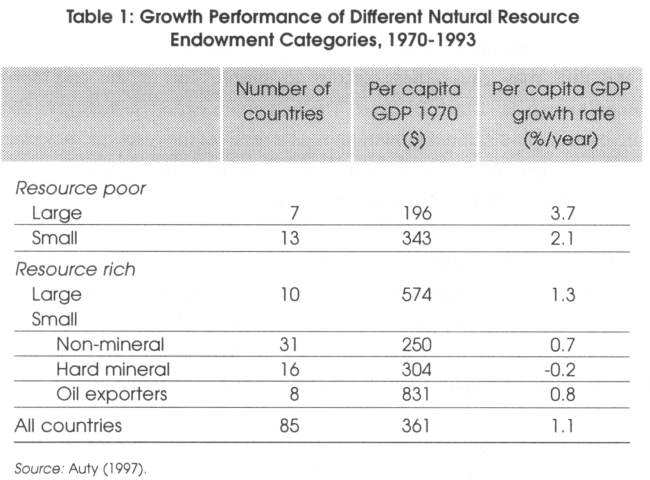
In the next sub-section we will discuss some of the reasons that have been advanced for the poor performance of natural resource abundant countries like Bolivia.
2.2 Theories on Poor Economic Performance and Natural Resources Abundance
Several explanations for the unsatisfactory performance of resource-rich countries have been advanced,3 and unfortunately these explanations complement each other rather than compete with each other. The explanations can be divided into external factors, which are instigated by changes in the terms of trade and price volatility, and internal factors that are associated mainly with the mismanagement of natural resource rents.
The first external problem is that the prices of primary products tend to be much more volatile than the prices of manufactured goods, which imply that the heavy reliance on just a few primary products subjects the country to high levels of volatility. This may lead to growth collapses like the one experienced in Bolivia in the early 1980s when world tin-prices plummeted.
The second external problem is that natural resource export booms tend to cause an appreciation of the exchange rate, which hurts the competitiveness of other export sectors, and thus may cause these sectors to shrink. This is the commonly cited phenomenon known as "Dutch Disease". The non-boom export sectors generally suffer lowered investment and stunted growth rates as a result of the resource movements and relative price changes. When the natural resource boom turns to bust, as the resource runs out or prices fall, the country is left with crippled alternative export sectors.
Another theory that might explain poor performance in resource rich countries asserts that non-resource export sectors may be key sources of 'learning by doing' where more rapid productivity growth takes place (Matsuyama 1 992; Sachs and Warner 1999). In this context, hampering growth in the manufacturing export sector through Dutch Disease entails a negative externality on dynamic economic growth.
Apart from these problems linked to external economic processes, there are a number of internal problems caused by natural resource abundance.
The first internal problem is that the availability of natural resource rents diverts efforts away from the process of productive wealth creation and into unproductive rent-seeking behavior, including corruption. This problem stems from the fact that the development of the natural resource sector changes the sectoral distribution of production to the detriment of other exporting sectors, such as modern agriculture. The effective result is a substantial reallocation of income within the economy. Often this includes the expansion of the public sector as easily taxed resource rents increase as a percentage of aggregate income. Even in the absence of corruption, the potential for dissipating national income with wasteful public sector spending increases.
The second internal problem is that the abundance of natural resources distracts governments from the need to develop human resources. As long as natural resources are abundant and can be used as a basis for growth and government revenues, there is less incentive to invest in human capital. This effect is reinforced by the fact that Dutch Disease tends to depress investment in high-skill exporting sectors, thus reducing investment in human capital formation (Gylfason et al. 1999). The result is an under-educated population without the skills and motivation to develop a dynamic manufacturing industry.
The third internal problem is that the mining of natural resources is usually a capital intensive activity with little employment creation and with few positive linkages to the rest of the economy (Hirshman 1958). The lack of positive linkages means that natural resource mining is likely to exist as a relatively isolated enclave within the economy and the likelihood that it spurs a virtuous circle of development spreading throughout the economy is extremely limited.
The fourth internal problem is that natural resource abundance tends to be associated with a more uneven distribution of income. This issue is the central topic of the present paper and will therefore be discussed in more detail in the following section.
3. Income Distribution and Natural Resources
Natural resources can affect a country's income distribution through several channels. One of the channels studied most in the literature is the human capital accumulation channel, where the basic assumption is that more investment in human capital and higher levels of education is associated with more equality. Here we find two competing hypotheses about the impact of natural resources. The first hypothesis argues that the abundance of natural resources causes governments to neglect to invest in human capital, which implies that natural resource abundance would lead to more inequality (e.g. Birdsall' et al. 2001; Gylfason 2001). The second hypothesis says exactly the opposite, namely that the natural resource rents soften the governments budget constraint and allows them to invest more in education (e.g. Davis 1995; Stijns 2001).
The empirical evidence on the effect of natural resource abundance on investment in education is mixed, if not contradictory (see Birdsall et al. 2001; Gylfason 2001; Davis 1995; Stijns 2001). The truth is probably that both of these opposing forces are simultaneously at work in any natural resource abundant country. Countries whose populations are divided into several competing factions (either by ethnicity or by high income inequality) are probably less likely to invest in mass education. Countries with more homogenous populations are more likely to reach the necessary consensus for high quality mass education (see Easterly 2001). Since Bolivia has both high ethnic diversity and high income inequality, there is a real danger that the first effect (neglecting education) might dominate.
Another channel through which natural resources affect income distribution is the distribution of rents. Since modern mining and hydrocarbon extraction tend to be highly capital intensive, a large part of the rents associated with extraction is likely to accrue to capital and only a small part to labor. Since capital owners tend to be rich and workers poor, this effect would tend to increase inequality. On the other hand, quite a large part of the rents is appropriated by the government, which creates scope for carrying out redistributive policies. Government programs and expenditures can influence inequality in a number of ways, some of which are pro-poor and some of which are not. Direct transfer payments could be used to augment the income of the poor. Such transfers, however, would have to continue indefinitely, and they thus create poor long-run incentives for growth. Instead government investment policies could be targeted at low-income earners, for example by improving infrastructure and basic services in poor neighborhoods. Current expenditure in health and education is perhaps the government activity with a redistribution objective that has performed the best. The most predictable impacts of government spending, however, also tend to be regressive.
High paying government jobs do not go to the neediest, nor do the contracts to carry public sector investment programs.
Although governments can directly affect income distribution somewhat through redistributive policies, the degree of income inequality is typically determined by the structure of the economy. Income inequality will more closely reflect the ownership pattern of capital assets in countries where capital commands a relatively large share of national income.4 Similarly, where human capital occupies a larger share of aggregate income, the distribution of income will follow more closely the disparities in education and the attainment of skills. Economies that rely more heavily on human capital tend to be more equal as the distribution of human capital is generally more uniform than the distribution of land and capital. Nevertheless, human capital itself can be a source of growing inequality. A study by ECLAC (1997) shows how a growing disparity in the wage gap between high skilled and low skilled jobs has fueled income inequality in the 1990s in Latin America.
While experiences of other countries and economic theory can suggest possible outcomes, income distribution is an empirical question. Each situation stands unto itself. It is difficult to predict how Bolivia's newfound Natural Gas wealth is going to affect the income distribution over the coming decades, because the use of the government's part of the rents is going to be crucial. However, it is possible to assume that the Bolivian government will not change its investment and expenditure patterns significantly after the discovery of Natural Gas. After all, Bolivia has been exploiting exhaustible natural resources for centuries, and Natural Gas is no different from the rest. This allows us to focus on the other mechanisms through which the Natural Gas is going to change the distribution of income.
Besides redistribution, there are two fundamental sources of income disparities: a) asset ownership, and b) the return to these assets. Asset ownership is the result of complex historical, political, and economic processes, and we will not try to explain how Bolivia has arrived at the current situation. We will take that as historically given and instead focus on how Natural Gas is going to affect the return to assets and thus the income distribution.
To study changes in wage rates and returns to fixed assets, one must turn to economic analysis. There are no easy generalizations about the relationship between economic changes and income distribution. Furthermore, changes in wage rates and returns to capital occur in a general equilibrium framework. For this reason, we simulate these changes using a Computable General Equilibrium (CGE) model.
Empirical observations and economic theory do guide our analysis and suggest mechanisms for changing levels of income distribution. For an economy in equilibrium with well-functioning markets, wage rates and returns to capital will reflect the value of marginal production derived from those factors, subject to the available production technologies. One generally reliable supposition is that economies that rely more on human capital for production will be more equal, although important differences may arise out of different labor categories.
Similarly, a large capital component in production is another potential avenue for inequality. This is mediated by asset ownership and the complexities of supply and demand in input, output and factor markets.
Changing productivity and differential growth in factor supplies will alter the profile of income distribution. Where technological advances increase the productivity of labor, we will observe increasing wage rates. If capital stocks grow at a rate greater than labor participation rates, we would expect wage rates and labor incomes to increase. Returns to capital should drop while stocks are increasing, such that it would be difficult to predict the impact on capital income.
The logic of these interactions between production, factor markets and income distribution apply to the different sectors of the economy as well, such that each sector will have a different contribution to the overall income distribution profile of the country. Changes in the sectoral composition of an economy will therefore have implications for income distribution.
4. The Structure of the Bolivian Economy
This section will provide an overview of the structure of the Bolivian economy. It has been divided into three sub-sections discussing three different topics of importance for the potential distributional impacts of Natural Gas exports: 1) employment and income distribution by labor types and sector of work; 2) government revenues from Natural Gas and other sources; and 3) international trade.
4.1 Employment and Income Distribution5
For the purposes of our distributional analysis, the economically active population of Bolivia has been grouped into the following six categories:
1. Rural small-holders
2. Agricultural workers
3. Non-agricultural workers
4. Urban informals
5. Employees
6. Employers.
The first group of rural small-holders includes mainly traditional farmers who cultivate a small piece of land, to which they may or may not have a formal title. The average monthly income for a rural small-holder in 1999 was Bs. 244, which corresponds to about US$37/month.
Agricultural workers do not own land but work for hire, mainly on a daily or weekly basis, on other farms. Agricultural workers are often in short supply, which means that they can command a relatively high wage. The average monthly income of an agricultural worker is about Bs. 724, which corresponds to about $110/month or about three times as much as a rural small-holder.
Non-agricultural workers are the urban equivalents of agricultural workers. They are available for hire on a daily or weekly basis, and work primarily in the construction sector. Non-agricultural workers are generally not in short supply, which means that they command a lower wage than agricultural workers. The average monthly income for this group is about Bs. 651, corresponding to about $100/month. We assume that all agricultural and non-agricultural workers are unskilled.
Urban informals constitutes an important part of all economically active persons in Bolivia. They obtain a small and irregular income from informal services and petty trade. The average monthly income for this group is about Bs. 415, corresponding to about $63/month. This group contains most of the urban poor.
Employees are skilled, to a smaller or bigger extent, and are employed with a fixed monthly income by an employer, which may be private or public. The average monthly income for employees amount to Bs. 1,240, corresponding to about $ 188/month. There is quite a large variation in incomes in this group, depending on the level of education.
Employers own their own company and hire people to work for them. They earn on average Bs. 2,683 per month, which corresponds to about $407/month.
Summary information on employment and average monthly incomes for each group is given in Table 2.
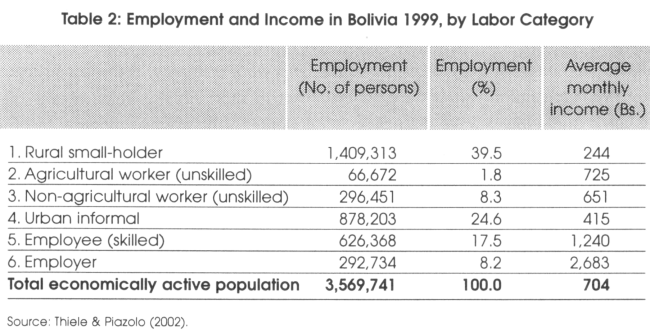
Unskilled workers often work in agriculture during some periods of the year and in non-agricultural during other periods. This means that it is reasonable to assume perfect mobility between these two labor categories. There are also quite large flows of rural-urban migrants who come from the rural small-holder sector and join the urban informal sector. Thus we also assume perfect mobility between these two groups. Between all other groups we assume that there is no possibility of moving within our time-horizon.
Workers can move between sectors, however, depending on where the job-opportunities are and where the salary is most attractive. The distribution of skilled and unskilled workers across sectors in 1999 is given in Table 3.
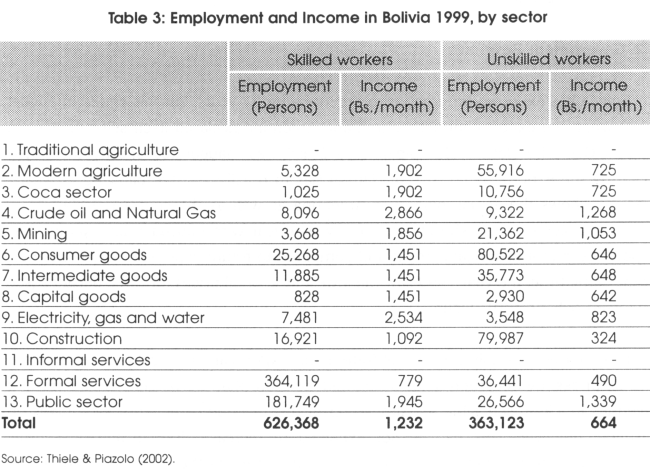
More than half of all skilled workers work in the formal service sector (12), where they on average earn the low salary of about Bs. 779/month. All the other sectors offer monthly salaries that are two or three times higher, but employment opportunities are limited, except for the public sector, which employs almost 30 percent of all skilled workers
Unskilled workers are spread more evenly across sectors. A job in the public sector is particularly attractive for unskilled workers as it pays a substantial wage premium. The hydrocarbon and mining sectors also pay well, but the number of jobs in these sectors is quite limited. There are many jobs in the construction sector (10), but they only pay Bs. 324/month on average.
Traditional agriculture (1) and informal services (11) do not employ any workers. These two sectors are assumed to be run by rural small-holders and urban informals. Their average monthly income was presented in Table 2 as Bs. 244 and Bs. 415, respectively. Clearly rural small-holders and urban informals are among the poorest groups of the Bolivian society, which implies that we should be particularly concerned about them in our distributional analysis of the impacts of the Natural Gas boom in Bolivia. Among these two disadvantaged groups, the rural small-holders are by far the worst off, however. Almost all rural small-holders are officially considered poor, and most of them lack access to one or more basic services, such as electricity, clean water, health and education services.
4.2 Government Revenues
Bolivia has exported Natural Gas to Argentina for 27 years, but this ended in August 1999 when the export contract expired and Argentina declared itself self-sufficient in Natural Gas. The Natural Gas pipeline to Brazil was inaugurated shortly thereafter, initiating the exports of 7.1 TCF of Natural Gas to Brazil over the following 20 years. Figure 1 shows the actual exports to Argentina as well as the contracted exports to Brazil until 2019. It also shows that 1999 was a year with unusually low Natural Gas exports both in a historical context and compared to future expected export volumes. At the same time, the year 1 999 saw the lowest level of oil prices for three decades (see Andersen & Faris 2001, Figure 1).
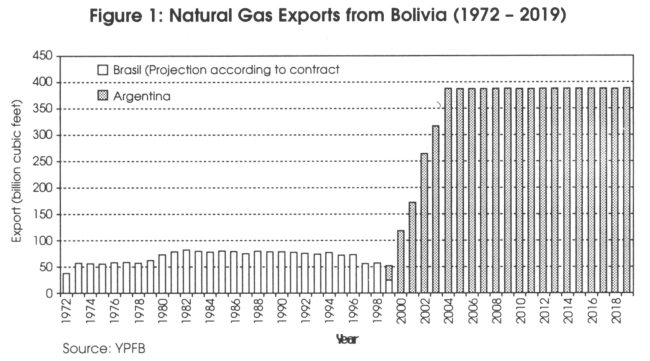
Despite the unusually low level of Natural Gas exports and unusually low level of gas and oil prices, hydrocarbon taxes accounted for more than 20 percent of government revenues in 1999 (see Table 4). Almost 2/3 of this revenue came from local taxes on gasoline, however. This part is not expected to increase dramatically over time. Royalties, however, are expected to increase dramatically as the volume of Natural Gas exports increase to comply with the contract with Brazil. At least a 7-doubling of the volume is to be expected, and the Natural Gas price (which is linked to world oil prices) has also increased substantially since 1999.
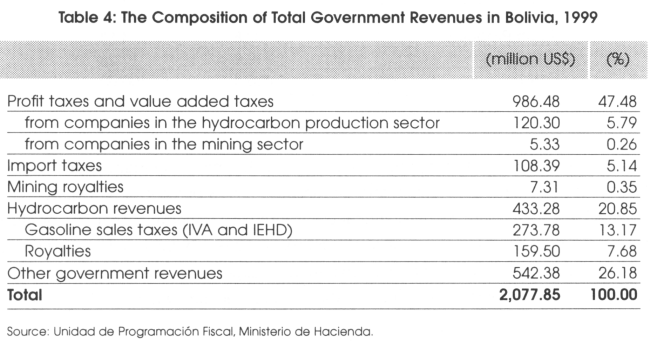
Furthermore, profit taxes and remittance taxes paid by the companies operating in the hydrocarbon sector are expected to increase as these companies start profiting from the exports to Brazil. YPFB (2001) estimates that annual royalties and taxes from the Natural Gas exporting companies will amount to about $300 million if prices remain around the level they were in 2000. Andersen & Faris (2001) show that if prices vary as much over the next 20 years as they did during the previous 20 years, annual revenues due to Natural Gas exports to Brazil could beanywhere between $141 million and $1.1 billion. No matter how oil prices develop in the future, government revenues are going to become much more dependent on the hydrocarbon sector in the coming decades.
Table 4 shows that the mining sector contributed virtually nothing to government revenues in 1999. This is despite the fact that mining was actually much more important than hydrocarbons in terms of exports. Mining products accounted for 38 percent of total exports in 1999, while hydrocarbons only accounted for 7 percent (see Table 5 below). The difference between the hydrocarbon sector and the mining sector in their contribution to government revenues is striking considering that both hydrocarbons and minerals are exhaustible natural resources, whose depletion ought to be compensated for through payments to the Bolivian society.
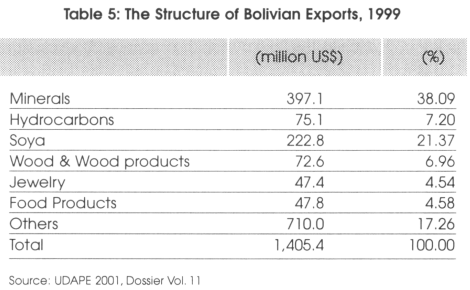
4.3 Trade and Openness
Rapidly increasing Natural Gas exports are likely to cause the exchange rate to appreciate. Any substantial appreciation of the real exchange rate will hurt other exporting sectors, so it is important to understand the present structure of Bolivian exports.
Figure 4 shows that the mining sector is by far the most important export sector. Minerals (mainly zinc, gold, silver, and tin) account for 38 percent of all exports. The export of soy beans from modern agriculture is also very important. That one product alone accounted for 21 percent of total exports in 1999. Hydrocarbon exports only accounted for 7 percent in 1999, but that share is expected to increase substantially during the next few years as explained in the previous section. Other significant export products include wood and wood products, which come from the intermediate goods sector, and jewelry and food products, which would come from the consumption goods sector.
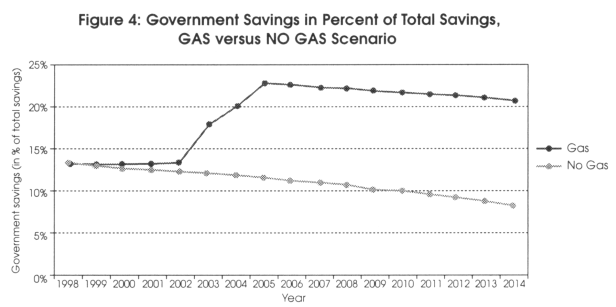
5. A Model of the Bolivian Economy
The Computable General Equilibrium (CGE) model used for this study is a standard 12-sector recursively dynamic model. There is one capital category and five types of labor: skilled, unskilled agricultural, unskilled non-agricultural, smallholder, and urban informal. Amongst the labor classes, labor is mobile only between the two unskilled classes and between the smallholders and the informal sector. There are six household categories defined by the source of their income.
This model is constructed using a social accounting matrix (SAM) for Bolivia in 1997, developed by Thiele & Piazolo (2002). The authors of the present paper modified this SAM to estimate the sources and parameters for different fossil fuel taxes and royalties.
For the production sectors, output, prices and factor demands are all determined endogenously within the model. Production is portrayed with a multiple-stage nested function. Labor and capital are combined in a Cobb-Douglas relationship to produce value added. Value added and composite intermediate goods are pooled in a constant elasticity of substitution (CES) function. Intermediate inputs are used in fixed proportions in the creation of the aggregate intermediate factor. This formulation is constructed to reflect the flexibility in production choices for medium to long-term processes.
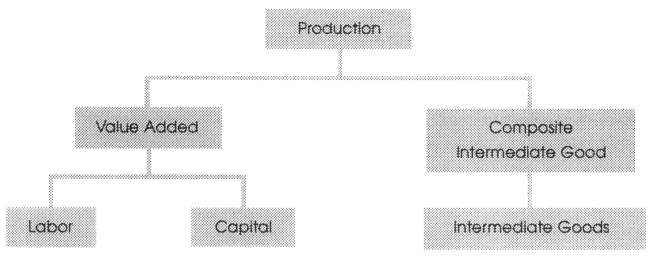
The utilization of capital and the five labor categories vary according to the sector, reflecting the factor use specification of the SAM. Capital is an input into production in all of the sectors, except for traditional agriculture, informal services and the public sector. Similarly, skilled labor is not used for traditional agriculture or the informal services sector. Instead, traditional agriculture uses only one factor, smallholder labor, which reflects an aggregate of household assets that are used in production This factor is also used in the coca sector. The urban counterpart to the smallholder factor is informal labor. Unskilled labor is found in all sectors except traditional agriculture. Although unskilled labor is divided into two categories, urban unskilled and rural unskilled, we assume the labor can move from one to the other. Similarly, the aggregate household factors, smallholder labor and informal labor, are substitutes, allowing the possibility of migration between rural and urban areas.
Following standard practice, the model assumes profit maximizing behavior in each of the sectors.6 Factors are hence employed in each sector such that the returns to each factor are equal to the marginal value product of the factor.
For the fossil fuel sector, production is fixed at the levels consistent with the contracts negotiated for Natural Gas exports and planned investments in the sector.
Although traditional agriculture and the urban informal sector use only informal labor and intermediates in production, these sectors are integrated into the larger economy in that these inputs are also used by other sectors. This formulation implies that the smallholder and informal sectors compete with other sectors for use of informal labor and act to absorb informal labor not employed in other sectors.7
The model is solved recursively over a fifteen-year time horizon. The model is run for each time period, after which the stocks of accumulated factors are updated before the model is run again for the next period. The key aspect of defining the dynamic relationship in a macroeconomic model is the treatment of savings and investment behavior. In this model, aggregate investment is determined by national savings. First, private savings are fixed as a fixed percentage of income for households and corporations according to their observed marginal propensity to save. Government savings is determined endogenously as the remainder, after predetermined expenditures are subtracted from current revenues. In the absence of a solid empirical basis for estimating foreign savings levels, these are set exogenously at historic levels. Once this level of aggregate savings is determined, the allocation of investment is determined by relative profitability based upon current prices. This is an alternative formulation to fully dynamic models where consumers and producers make savings and investment decisions based upon perfect price information for all future periods, recognizing that decision-makers are imperfect predictors of the future. Macroeconomic closure in this model is achieved by allowing the real exchange rate to adjust to achieve equilibrium while foreign savings and the domestic price index are set exogenously. The model does not describe the financial sector of the economy so that savings, investment and capital accumulation are determined entirely via the real side of the economy.
The relationship between imports and domestically produced commodities, as well as the relationship between exports and domestically consumed commodities, are treated in the standard way for CGE models, using an Armington function for imports and a constant elasticity of transformation (CET) function for exports. This formulation entails the imperfect substitution between these different commodities which allows for two-way trade as in observed trade relations. The sectoral definitions of the SAM distinguish between industrial sectors that produce goods that are used primarily for consumption, intermediate production and capital investments. This permits the elasticity of substitution between imports and domestically produced goods for these different sectors to vary, and hence for scenarios to look at different taxation schemes and world price trends by import type.
The operation of labor markets follows De Santis (2000). Using the empirical observations of Blanchflower & Osward (1994) and others, a relationship between real wage rates and unemployment is specified, where higher wages coincide with lower unemployment. The empirical basis of the 'wage curve' mimics a labor supply curve when specified in a simulation model.8 Thus the labor markets operate on the principles of supply and demand in the model, rather than the often used simplifications of fixed wage rates or fixed labor supply curves.
The specification of production in the hydrocarbon sector differs from the other sectors of the economy, in that production is not allowed to respond to changing prices. Output of petroleum and Natural Gas is predetermined in the model by the currently projected exports under contract with Brazil and the associated investments in the sector.9
6. The Impact of Natural Gas Exports to Brazil
The potential benefits to be derived from an increase in natural gas sales concentrate primarily in providing a source of foreign exchange, a source of savings for carrying out investments (private or public), and as a source of revenue for the public sector. There are, however, substantial indirect impacts that will result from the large infusion of foreign exchange into the economy. In this section, we analyze the impact of Natural Gas on the Bolivian economy by comparing simulations generated by the CGE model. First, we compare the scenario that is constructed using the expected increase in Natural Gas sales (hereafter GAS) with a scenario that holds Natural Gas exports constant at 1997 levels (hereafter NO GAS). The apparent benefits from the increase in Natural Gas are substantial. Estimated annual growth is 2-3 percent higher for the period in which exports sales are growing rapidly (See Figure 2). In subsequent years, the higher annual growth rate disappears as the rate of growth drops back very close to the level predicted with no increase in gas sales. The estimated benefits are persistent as the economy continues to grow upon a larger economic base.
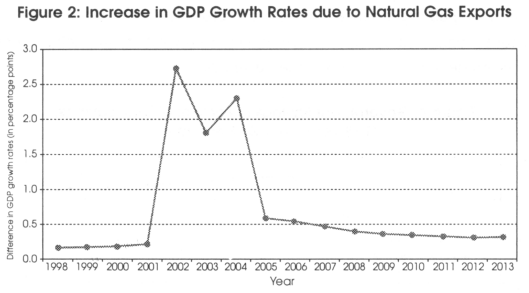
GDP is 10 percent higher after 16 years in the GAS scenario compared to NO GAS (see Figure 3). This increase in growth is brought about not only by the increase in fossil fuel sales - the demand-side impact - but also by an increase in national savings as a result of the petroleum sales, which leads to higher investment and larger capital stocks - the supply-side impact. National savings and investment levels are estimated to be about 20 percent higher in the GAS scenario. Again, a substantial portion of this increase in national savings is drawn directly from the increase in Natural Gas revenues. An additional source of higher national savings is the result of cumulative growth: Higher investments lead to higher overall economic activity that brings on higher aggregate savings and investment and so on.
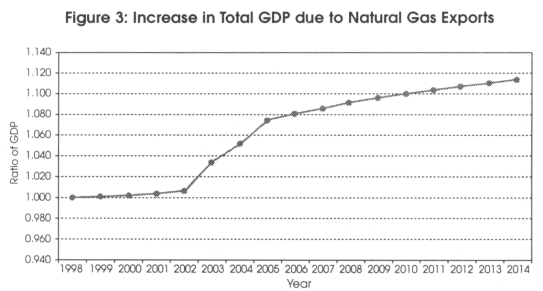
A substantial portion of the increase in the national savings rate is made up of government savings, which climbs to over 20 percent of total national savings, as compared to about 12 percent without (see Figure 4). For better or worse, public investment will play a larger role in Bolivia. This topic will be explored in more detail later.

The increase in fossil fuel revenues accruing to the government also creates an increased dependence on natural resources in the public sector. Fossil fuel's contribution to government revenues increases from about 10 percent to about 20 percent. This stems not only from the increase in fossil fuel taxes destined to the government but also by a reduction in tax receipts in sectors that are negatively impacted by the economic changes. The increase in revenue presents the government with many options, including a reduction of other taxes that are more distortionary or an expansion of publicly financed investment projects. These possible benefits are partially counter-balanced by the concern of increased volatility in public revenues and of the increased dependence on fossil fuel revenues.
The increase in GDP growth rates is also accompanied by a substantial change in the structure of the economy. The most dramatic change is the increase in the size of the petroleum and natural gas sector. The impacts of these economic changes on the other sectors of the Bolivian economy take place through a number of interrelated processes, the most important of which are changes in relative input and output prices, overall growth of the real economy and shifts in demand. The most immediate impact is in those sectors and segments of the economy with direct linkages to the fossil fuel sectors which benefit through higher demand for capital, labor and intermediate inputs. The portion of additional income earned through natural gas and petroleum sales that remains in Bolivia contributes to an expansion of the overall economy, increased consumer demand, higher aggregate savings and greater investment.
The relative price changes that occur in this open economy model are strongly influenced by movements in the exchange rate. The predicted appreciation of the real exchange rate brings about the classic relative price shifts associated with Dutch Disease. Exports will command lower prices in terms of the domestic currency, while imports become relatively less expensive. This tends to hurt the non-boom export sectors of the economy as they receive lower output prices. The non-tradable sector generally receives higher output prices. For the boom sector, in this case petroleum and natural gas, increased output may be partially offset by lower relative prices.
The simulations show an appreciation of the real exchange rate that peaks at a level that is almost 5 percent stronger than that of the NO GAS scenario. This real appreciation of the exchange rate is persistent, leveling off at a level 2 percent stronger. This constitutes a mild case of Dutch Disease - imports will be cheaper and will command a larger percentage of domestic sales and the profitability and revenues for export sales in domestic currency will be lower, suppressing the non-fossil fuel export sectors.
Changes in the relative prices of inputs is another important factor in the sectoral incidence of these economic changes. Those sectors that rely more heavily on imported intermediate inputs will tend to benefit from lower input costs, just as those that use more domestic intermediate inputs will experience relatively higher production costs.10 Changes in the cost of capital and rising wages will also impact production costs, though these changes will tend to be more evenly distributed across all sectors. Finally, the overall growth of the economy has a positive impact on all the sectors, all else being constant, through an increase in consumer demand. The analogous increase in investment demand plays an important role in the impact on the different sectors of the economy, as rapid growth and the ensuing investment boom draws most heavily from a few sectors of the economy; the construction and capital goods sectors provide almost 88% of the goods and services required for new investment.
As seen in Figure 5, the export-oriented mining sector suffers the biggest short-term decline, followed by the modern agricultural sector. Consumer goods and traditional agriculture experience a similar decline in the first few years of the natural gas boom, though not as severe. These declines can be explained largely by the appreciating real exchange rate, which lowers export prices and subjects these sectors to increased competition from imports. All of these sectors also rely more upon domestic intermediate goods, which become more expensive, contributing to their relative decline.
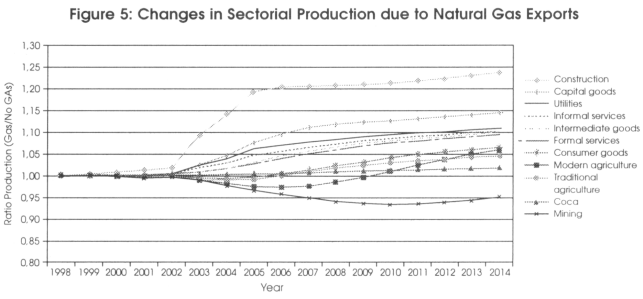
Apart from the fossil fuel sector itself, the construction and capital goods sectors benefit the most from the changes, bolstered by the investment boom as well as declining prices for imported intermediate goods. The remaining sectors, including services, intermediate goods and utilities, are predominantly non-tradable and as such benefit from favorable relative price changes, offsetting any increases in production costs.
The overall expansion of the economy helps all sectors. The recovery of the agricultural sectors in later years indicates that the impact of increased overall investment and growth in the economy may be larger than the impact of relative price changes due to the appreciating exchange rate. The only sector in which production is not ultimately higher is mining.
These economic changes bring with them difficult political questions. International experiences show that the negative impacts experienced in some sectors of the economy has in some cases led to government intervention to mitigate losses felt in the export and import competing sectors. Interventions to buffer short-term losses and to ease transition periods are understandable. However, these expenditures are difficult to remove once introduced. Most agree that these types of support expenditures are tremendously wasteful and have contributed to the stagnation and inefficiency of industrial production in many countries.
The change in relative prices that accompanies a natural resource boom may constitute a permanent change in the economy. This in itself is not a problem. The advantages of a stronger real exchange rate - such as increased purchasing power through inexpensive imports - compensate for the disadvantages if the exchange rate properly reflects economic fundamentals. In this case, a more complete adjustment to the new economic context is preferable to maintaining an economic structure that is no longer competitive in the face of this new reality.
As one of the main exporting sectors in Bolivia, the mining sector is likely to suffer from a fall in profitability due to the Dutch Disease effects that arise from increased Natural Gas exports. Since the mining sector in Bolivia has strong labor unions that tend to be very vocal, the government is likely to experience a lot of pressure to compensate the growing group of unemployed miners. Rather than trying to artificially maintain the mining sector in Bolivia at any particular size through government subsidies, the government should help the miners make the transition to other sectors. This includes stimulating job creation in other sectors, perhaps simply by removing obstacles to the development of small and medium sized enterprises.
As we discussed in a previous section, economies that are highly dependent on natural resource face a set of particular challenges emanating from the windfall. Natural resource booms may cause governments to invest sub-optimally, but before returning to this point in Section 8, we now return our attention to the issue of income distribution, keeping in mind that the results of the scenarios presented in the following section might be overly optimistic.
7. The Distributional Impact of Increasing Natural Gas Production
In order to assess the distributional impact of the increase in Natural Gas sales in Bolivia, we observe the predicted difference in wage rates and returns to capital that accompanies the resource boom. We also map the difference in income accruing to seven household and institutional categories. Starting with wages, we see from Figure that wages increase for all strata. Given the strong aggregate benefits of the Natural Gas sales presented in the previous section, this is not a surprise. Driven by higher investment, increasing capital stocks push up the marginal productivity of labor which is translated into higher wage rates. This rise in relative wage rates is counter-balanced by a drop in the average return to capital. The falling returns to capital predicted by the model are the result of the relative abundance of capital in the assumed absence of productivity gains.
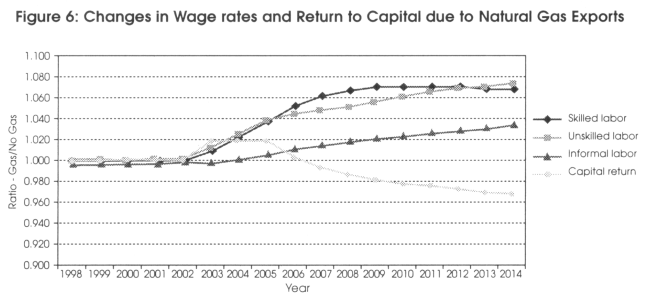
When predicted changes in wage rates are combined with predicted changes in employment of different factors, we can observe the total changes in factor incomes. Due to more investment and higher growth, employment of all factors is higher in the GAS scenario than in the NO GAS scenario, thus implying higher incomes to all factors (see Figure 7). However, the incomes to the two large groups containing most of Bolivia's poor people, rural small holders and the urban informal sector, do not increase as much as the incomes to the three richer groups (capitalists, skilled workers, and unskilled workers), thus implying an increase in income inequality.
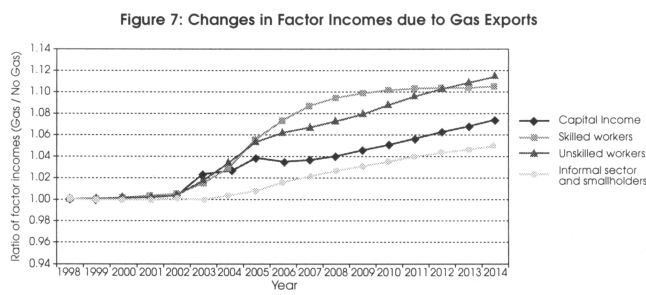
The answer to the question of how changing wage structures ultimately influence household income depends upon the structure of the labor markets, as well as the allocation of income between labor and capital. In particular, the distribution of income will depend on how different segments of the labor market react to changing wages and the degree to which barriers between different segments of the labor market and between employment in various sectors inhibit the movement of labor. For example, if one were to assume that labor can flow freely between skilled, unskilled and informal labor segments, this would greatly overstate the fluidity of labor markets in Bolivia. On the other hand, to assume that all workers are locked into a segment understates the capacity to adapt to economic changes. In this analysis, we make two key assumptions that shape the results presented here. First, that labor from a given segment of the market can move freely between the different productive sectors. Second, that unskilled workers and those in the informal market can move between rural and urban markets, but not between these two segments of the labor market. There is no upward or downward mobility permitted. This assumption is supported by Andersen (2003) which indicates that the degree of social mobility in Bolivia is very low.
The skilled and unskilled workers fare comparatively better, as the sectors in which they are employed tend to expand at a greater rate than the informal sectors. However, this is not uniformly true across all sectors. There are comparatively fewer employment opportunities for unskilled agricultural workers, setting off a migration into urban and industrial sectors. A similar movement takes place away from the traditional agricultural sector to the urban informal sector. Again, while the results of the simulations exhibit comparatively fewer agricultural and mining jobs with the natural gas expansion, there is not an absolute decline in employment in the rural areas. Although this implies that the rural sectors may not be in the position to absorb the projected future growth in the labor pool, it does not suggest that current jobs will be lost there.
These observations are reiterated in looking at the distribution of income across households. As we see in Figure 8, employers and unskilled workers fare the best with an expansion of Natural Gas. Unskilled workers are employed in many of the sectors that benefit the most from the economic changes, particularly construction and services. The smallholders and urban informal sector gain the least.
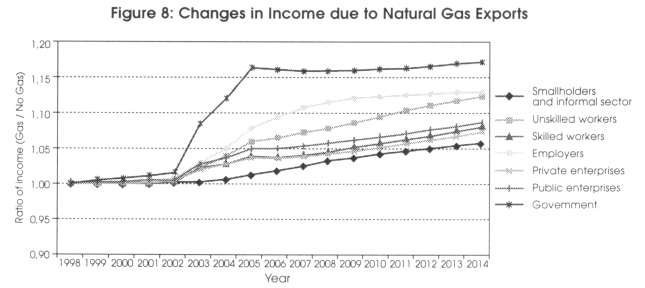
Despite the drop in average returns to capital, the income accruing to capital increases as more capital is brought into production. Hence income to employers, who earn their income from capital returns, displays significant increases. This of course implies that the return to existing capital is lower and that only those who have invested in the more profitable sectors of the new economy experience an increase in income. The owners of capital in agricultural and mining sectors will experience a drop in income in this context.
Alternative assumptions regarding the fluidity of labor markets would produce different results. If the option for rural unskilled workers and smallholder agricultural producers to move to urban opportunities were not there, the economic changes would affect these rural segments of society more severely. As in the face of any significant economic change, it is the extent and rate in which producers and households are able to adapt to the new economic circumstances that determines the impact of the changes, either in terms of the damage from an economic shock or the benefits of an economic boom.
Any measures that increase the ability of labor to move between segments of the labor market will reduce the disparity in the economic impacts of these changes between different segments of society. Were greater mobility assumed in these simulations, we would observe a shrinking of the informal sector as labor moves into skilled and unskilled segments of the formal sector.
In summary, Natural Gas exports could potentially increase incomes for all, alleviating poverty and creating more jobs. However, Natural Gas exports appear to benefit most the groups who initially earned higher incomes, causing increased inequality. This might be offset, however, if the government successfully invests its hydrocarbon revenues with redistribution as a specific goal.
8. A Less Optimistic Version of the Story
In this section we address the questions of income growth and distribution in a more sober light, recalling that natural resource dependence has been associated with poor growth. From the numerous potential problems associated with a large natural resource sector that we outlined earlier, we have only accounted for the issues related to Dutch Disease in the simulations of the previous section. These simulations therefore incorporate the most important benefits of natural resource exports: natural resource sales provide a source of foreign exchange, government revenues and funds for investment. As such, these scenarios might be best considered as an optimistic estimation of the benefits of expanding Natural Gas in Bolivia, better describing the potential benefits rather than the most likely result. The actual benefits will depend on the success in Bolivia of addressing the domestic policy challenges associated with the growth in Natural Gas sales.
The relatively sanguine results presented above are based upon a growth in savings and investment stemming from the increase in fossil fuel sales. The empirical evidence is not clear regarding the relationship between investment and natural resource sales. It is difficult, however, to imagine a scenario where aggregate investment could drop with an increase in fossil fuel export sales, except if this coincided with a decrease in growth. Otherwise, the diversion of resources into consumption and capital outflows would have to exceed the total increase in revenue. We are thus inclined to only seriously consider a decline in growth precipitating a drop in savings and investment, rather than the reverse.
Another limitation of this modeling approach is that we do not allow for endogenous productivity growth. Growth in this model relies solely upon factor accumulation. Given the lack of a strong empirical basis for estimating the determinants of productivity growth, we elected to exogenously set productivity growth. Furthermore, for simplicity, we set productivity growth at zero. There is considerable debate whether economic growth is better described by factor accumulation driving productivity growth, or productivity growth driving factor accumulation. It is undisputable that both are essential ingredients in modern growth. In this analysis, we are primarily concerned with the difference in economic performance between scenarios. The arbitrary treatment of productivity growth therefore only biases the results to the extent that productivity growth differs across different scenarios. Given the poor performance of so many economies that rely heavily on natural resources, it is natural to assume that natural resource extraction somehow inhibits productivity growth, and that including this impact would erode the estimated benefits of an increase in Natural Gas sales. An interesting topic for future research would be to disentangle the impact of natural resources on growth, accounting separately for the impact on factor accumulation and productivity growth.11
We proceed here by pursuing the question of capital accumulation. Given that we have discounted the prospect of a surge in natural resource revenues directly reducing aggregate investment, we introduce the possibility of poorly performing investments. To simulate the impact of bad investments, we analyze the results of the model using different values for a parameter that describes the efficiency of investment spending in creating new capital. The question at hand is whether all investment spending is equally effective at producing new capital, as is often assumed in analyses of growth and in estimating capital stocks (see Pritchett 2000). However, practical experience and a large body of anecdotal evidence points to the contrary. Investment spending is often misallocated, wasted, misappropriated or funneled into consumption. For the base scenarios reported earlier we followed the convention that one Boliviano of investment creates one additional Boliviano of capital. To create less optimistic scenarios, we consider the impact of setting this capital creation parameter at 0.5 and 0.25 for the amount of investment that originates from government fossil fuel revenues. Setting the capital creation efficiency parameter at 0.5 implies that half of all government investment derived from fossil fuel sales does not succeed in creating productive capital. In these scenarios, the economy still enjoys the full demand-side benefits of Natural Gas sales, but the supply-side expansion is reduced.
As can be seen in Figure 9, aggregate production is still higher with the increase in Natural Gas sales even with an acute waste of fossil fuel revenues by the government. The results of these scenarios also reflect the impact of shifting revenues into higher consumption or current expenditures - ineffective investment spending is comparable at the aggregate level to directing fossil fuel revenues to current consumption or to the inappropriate expropriation of public resources. The possibility that some of the natural resource revenues may leak abroad effectively reduces the size of the boom, but does not change the fundamental dynamics.
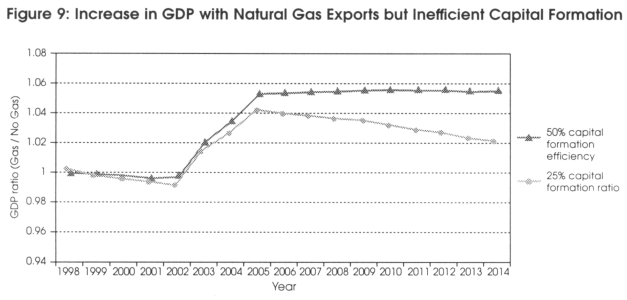
In conclusion, it takes more than a profligate squandering of public revenues to completely negate the benefits of natural resource exploitation. The implication of natural resources inhibiting growth - a notion that has considerable empirical support - is that we would observe a drop in GDP comparing the increase in Natural Gas sales to the scenario with no increase. We must look for different explanations if we are to support the notion that natural resource exploitation suppresses economic growth.
We see in these less-optimistic scenarios that the consideration of the distributional impacts from an increase in Natural Gas exports becomes more compelling. In Figure 10 we present the time path of the ratio of average incomes between the two scenarios for different segments of Bolivian society when 50 percent of government investments stemming from fossil fuel revenues are unproductive. We observe a longer period with depressed incomes for all segments of the economy, and the total income accruing to unskilled agricultural workers and smallholders recovering to the level of income without an increase in Natural Gas sales only after a decade. In this scenario, the influence of overall aggregate growth is not enough to offset the economic harm suffered by some segments of society as a result of Dutch Disease. In summary, unless the boost in fossil fuel production can bring about a substantial rise in investment and growth, the distributional implications become much more worrisome with the possible reduction in income for some of the poorest segments of the population.
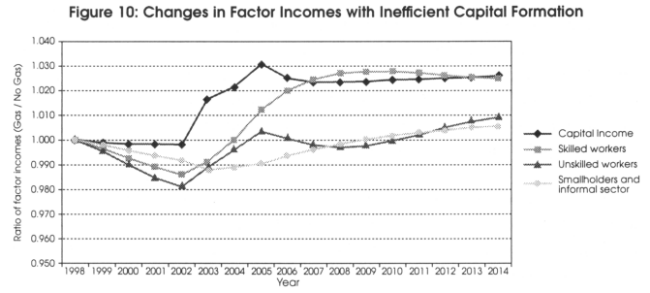
The practical implications from this analysis are that the government of Bolivia must walk a delicate line between progressive social policy and adherence to stringent investment guidelines. Bolivia must avoid the poor investment performance experienced by so many countries in the wake of natural resource booms. To achieve this, the best prescription is to invest in carrying out strict project appraisal, ensuring adequate review and oversight and effectively recognizing the true scarcity value of this new-found capital. Smoothing public expenditures through a stabilization mechanism would help in this regard (Andersen and Faris 2001). Nevertheless, investments in human resource development, particularly health and education spending for the poorest segments of society, are essential. These investments are more difficult to evaluate within the confines of a traditional benefit-cost framework. Nevertheless, following fundamental project guidelines and the principles of accountability and transparency will reduce misallocation and waste.
9. Conclusions
The results of the simulations carried out in Sections 6 and 7 indicate that increasing Natural Gas exports has the potential for increasing wages and incomes for all the groups studied in this analysis. This is good for growth and poverty alleviation. Inequality does appear to increase, however. The smallholders and informal sector workers do not benefit to the same degree as formal sector labor, both skilled and unskilled, and those that receive capital returns. These results rely upon a healthy growth response to the surge in natural resource exports while experience indicates that this is far from inevitable. Less optimistic scenarios indicate that falling incomes amongst some of the poorer segments of Bolivian society is also a real possibility.
In general, it is crucial how the government spends its substantially increased revenues due to Natural Gas exports. If the government invests the money wisely, all major population groups should benefit from the Natural Gas boom, although some will gain more than others. If, in addition, the government invests the Natural Gas revenues with a focus on poorer segments of the country, poverty reduction could be substantial.
A large part of the Natural Gas revenues are going to accrue to state governments, especially in Tarija and Santa Cruz. The state governments occupy an ill-defined position between the central government and the municipal governments, where the responsibilities and priorities are not as clearly delineated. The administrative systems at the state level are also less prepared for managing large and volatile inflow of funds
increasing the possibility that these funds will not be put to their best use. Given this context, it would be prudent to make an effort to clearly articulate the goals and development strategies to which natural resource revenues will be directed. The lessons and experiences from recent National Dialogues and the creation of the Poverty Reduction Strategy for the use of the HIPC debt relief provide a strong guide for strengths and limitations of such a process.
Bolivia is in the position to carefully consider the best mechanisms for allocating and monitoring the use of the revenues derived from the increase in Natural Gas sales, building on past experience and the experiences of other countries to avoid the numerous pitfalls. The question of earmarking natural resource revenues, instituting more stringent accounting guidelines and designing fiscal policy instruments such as a stabilization fund should be close to the top of the national agenda.
Notes
* This paper was prepared for the Andean Competitiveness Project. Financial assistance from the Andean Development Corporation (CAF) is greatly appreciated, and the authors are thankful for the excellent research assistance provided by Fernando Montaño and Jim Shyne. We are particularly indebted to Rainer Thiele, Daniel Piazolo and Manfred Wiebelt at Kiel Institute of World Economics for their work on the disaggregated Social Accounting Matrix for Bolivia, without which this paper would have been impossible to produce.
** Lykke E. Andersen, Senior Economist, Grupo Integral, La Paz. Robert Faris, Economist, Harvard University, Cambridge, Massachusetts.
1 Proven (P1) and probable (P2) certified reserves by 1 January 2003.
2 Number 19 out of 232 according to http://www.leksikon.org/html/dk/sort_stat_9.htm. Countries that are more land abundant per capita than Bolivia include Greenland, West Sahara, Mongolia, Australia, Canada, and Kazakhstan.
3 Auty(1998).
4 This should not be confused with the capital-intensity of production. Highly capital-intensive production, for example manufacturing, is more often associated with low inequality.
5 This section is based on information from the 1999 MECOVI survey carried out by INE (Instituto Nacional de Estadística) and processed by Rainer Thiele and others at Kiel Institute of World Economics (see Thiele et al (2002).
6 The validity of this assumption for the traditional agricultural sector might be questioned given the portion of production that is destined for home consumption. Nonetheless, this sector will be sensitive to changing prices, although the model may misstate this sensitivity somewhat.
7 This simple structure for traditional agriculture and informal sectors means that these sectors do not accumulate capital over time, as the other sectors. Factor accumulation is only via an exogenously set growth rate, as for other labor categories. Incomes from households that rely solely on informal sector and traditional agricultural activities therefore do not include any returns from savings or investments. This might bias the results up or down, depending on the course of asset accumulation in these households.
8 The demand for labor in this formulation still slopes downwards so that the productive sectors will hire less labor when wage rates are high. The supply side response brings more labor into the market when wage rates are high.
9 A full list of equations and the computer code for the model is available from the authors: Robert_Faris@Harvard.edu and landersen@grupointegral.bo.
10 We do observe, as expected, a shift in the composition of inputs with these price changes towards an increased use of imported inputs, although subject to a degree of rigidity as domestic and imported inputs are not perfect substitutes.
11 In scenarios not reported here, we do not find support for the theory that stronger productivity growth in the tradable sector can account for the poor growth associated with natural resources. Growth can be marginally improved by addressing the dynamic externality associated with reduced investment in the tradable sector resulting from Dutch Disease. This does not, however, begin to explain how taking advantage of natural resources could reduce growth. If this were to be true, then natural resources must reduce productivity growth, not just penalizing the sector where growth might be stronger.
REFERENCES
Andersen, L. E. (2003) "Baja movilidad social en Bolivia: causas y consecuencias para el desarrollo." Revista Latinoamericana de Desarrollo Económico, No. 1, pp. 11-36. Septiembre. [ Links ]
Andersen, L. E., and R. Faris (2001) "Reducing volatility due to Natural Gas exports: Is the answer a Stabilization Fund?" Institute for Socio-Economic Research, Universidad Catolica Boliviana. Working Paper No. 11/2001. December. [ Links ]
Auty, Richard M. (1997) "Natural Resources, the state and development strategy." Journal of International Development, Vol. 9, pp. 651-63. [ Links ]
Auty, Richard M. (1998) "Resource Abundance and Economic Development: Improving the Performance of Resource-Rich Countries" UNU/WIDER Research for Action No. 44. [ Links ]
Auty, R. M., and R. F. Mikesell (1999) Sustainable Development of Mineral Economies. Oxford: Oxford University Press.
Birdsall, N., D. Ross, and R. Sabot (1997) "Education, growth and inequality." In: N. Birdsall, and F Jasperson (eds.). Pathways to Growth: Comparing East Asia and Latin America. Washington DC: Inter-American Development Bank, pp. 93-127. [ Links ]
Blanchflower & Osward (1994) "An Introduction to the Wage Curve." Journal of Economic Perspectives Vol. 9:153-167. [ Links ]
Davis, G. A. (1995) "Learning to love the Dutch disease: Evidence from the mineral economies." World Development. Vol. 23, pp. 1765-1779. [ Links ]
De Santis (2000) "The Impact of a Customs Union with the EU on Turkey's Welfare, Employment and Income Distribution: An AGE Model with Alternative Labour Market Structures." Journal of Economic Integration. Vol. 15: 195-238.
Duncan, R. C. (1993) "Agricultural export prospects for sub-Saharan Africa." Development Policy Review. Vol. 11, pp. 31-45. [ Links ]
Easterly, William (2001) The Elusive Quest for Growth. Cambridge: MIT Press. ECLAC (1997) The Equity Gap. Latin America, the Caribbean and the Social Summit. Santiago, Chile: Economic Commission for Latin America and the Caribbean. [ Links ]
Gylfason, T. et al. (1999) "A Mixed Blessing: Natural Resources and Economic Growth." Macroeconomic Dynamics. Vol. 3, pp. 204-225. [ Links ]
Gylfason, T. (2001) "Natural resources, education, and economic development." European Economic Review. Vol. 45, pp. 847-859. [ Links ]
Hirschman, A. O. (1958) The Strategy of Economic Development. Yale studies in economics, 10, Yale University Press, New Haven. [ Links ]
IDB (1998) "Facing Up to Inequality in Latin America." The Inter-American Development Bank, Washington, D.C. [ Links ]
Karl, T. L. (1997) The Paradox of Plenty: Oil Booms, Venezuela, and Other Petro-States. Berkeley: University of California Press. [ Links ]
Lal, D. (1993) The Repressed Economy: Causes, Consequences, Reform. London: Edward Elgar.
Leamer, E. E., H. Maul, S. Rodriguez, and P. Schott (1999) "Does Natural Resource Abundance Increase Latin American Income Inequality?" Journal of Development Economics. Vol. 59, pp. 3-42. [ Links ]
Matsuyama, K. (1992) "Agricultural productivity, comparative advantage, and economic growth. "Journal of Economic Theory. Vol. 58, pp. 317-334. [ Links ]
Nankini, G. T. (1979) "Development problems of mineral exporting countries," World Bank Staff. Working Paper No. 354. Washington DC: World Bank. [ Links ]
Pritchett, L. (2000) "The Tyranny of Concepts: CUDIE (Cumulated, Depreciated, Investment Effort) is Not Capital. "Journal of Economic Growth. Vol. 5, pp. 361-384. [ Links ]
Sachs, J., and A. Warner (1995) "Natural Resource Abundance and Economic Growth." NBER Working Paper No. 5398. Cambridge MA: National Bureau of Economic Research. [ Links ]
Sachs, J., and A. Warner (1999) "The Big Push, Natural Resource Booms and Growth." Journal of Development Economics. Vol. 59, pp. 43-76. [ Links ]
Stijns, Jean-Philippe (2001) "Natural Resource Abundance and Human Capital Accumulation." University of California at Berkeley, Department of Economics. Draft.
Thiele, Rainer, and Daniel Piazolo (2002) "Constructing a Social Accounting Matrix with a Distributional Focus - The Case of Bolivia." Kiel Institute of World Economics. Working Paper No. 1094. January. [ Links ]
Tornell, A., and P. Lane (1994) "Are Windfalls a Curse? A Non-Representative Agent Model of the Current Account and Fiscal Policy." NBER Working Paper No. 4839. Cambridge MA: National Bureau of Economic Research. [ Links ]
Williamson, J. G. (1997) "Growth, Distribution and Demography: Some Lessons from History." NBER Working Paper No. 6244. Cambridge MA: National Bureau of Economic Research. [ Links ]
Wood, A., and K. Berge (1997) "Exporting manufactures: Human Resources, Natural Resources and Trade Policy. "Journal of Development Studies. Vol. 34, pp. 35- 59. [ Links ]
YPFB (2001) "Informe Mensual Noviembre - Diciembre 2000" Vicepresidencia de Negociaciones Internacionales y Contratos. La Paz. [ Links ]














